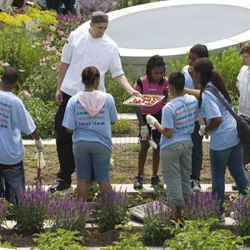Professional Practice
Children: Obesity

Childhood obesity rates have risen dramatically over the past 30 years, tripling from 1980 to 2008. According to the Centers for Disease Control and Prevention, almost 19 percent of young people aged 6–11 years are obese while more than 17 percent of 12 to 19 year olds are, equaling some 12.9 million American children. In a 2009 study, the CDC estimates that the total cost of obesity in the United States reached $147 billion.
How Nature Helps
Research published in the American Journal of Preventative Medicine shows that children who are active outdoors are less prone to obesity than their counterparts that spend hours inside in front of their TVs and computers.
A study published in the American Journal of Clinical Nutrition has also shown there is a connection between obesity in children and deficiency of Vitamin D, which comes from not spending enough time outside.
Research
“Childhood Obesity and Proximity to Urban Parks and Recreational Resources: A Longitudinal Cohort Study,”
Health and Place, 2011
"Vitamin D Deficiency and Anthropometric Indicators of Adiposity in School-Age Children: A Prospective Study,"American Journal of Clinical, Nutrition 2010
"Using Nature and Outdoor Activity to Improve Children’s Health," Current Problems in Pediatric and Adolescent Healthcare, 2010
“Neighborhood Greenness and 2-year Changes in Body Mass Index of Children and Youth,” American Journal of Preventative Medicine, 2008
“Physical Activity Among Adolescents: When do Parks Matter?" American Journal of Preventative Medicine, 2008
 ASLA 2010 Professional General Design Honor Award, Rooftop Haven for Urban Agriculture, Chicago, Illinois, Hoerr Schaudt Landscape Architects / Image credit: Scott Shigley
ASLA 2010 Professional General Design Honor Award, Rooftop Haven for Urban Agriculture, Chicago, Illinois, Hoerr Schaudt Landscape Architects / Image credit: Scott Shigley
Resources
Rx for Outdoor Activity, Children and Nature Initiative
Active Living, ASLA
Organizations
Active Living Research
Community Gardening Association
Let’s Move Outside
Children & Nature Network
Role of the Landscape Architect
Landscape architects design gardens, which act as both classrooms and places to grow healthy fruits and vegetables, as is the case with the Gary Comer Rooftop Garden in Chicago. This rooftop garden provides kids with a chance to work outside and be active while learning.
Landscape architects also design streetscapes that are safe and walkable, as well as beautiful, encouraging kids to add a level of activity to their day to day lives.
Case Studies
Gary Comer Rooftop Garden, Chicago, Illinois Hoerr Schaudt Landscape Architects
SW 12th Avenue Green Street, Portland, Oregon, Kevin Robert Perry, ASLA
<< Nature Deficit Disorder
Stress >>